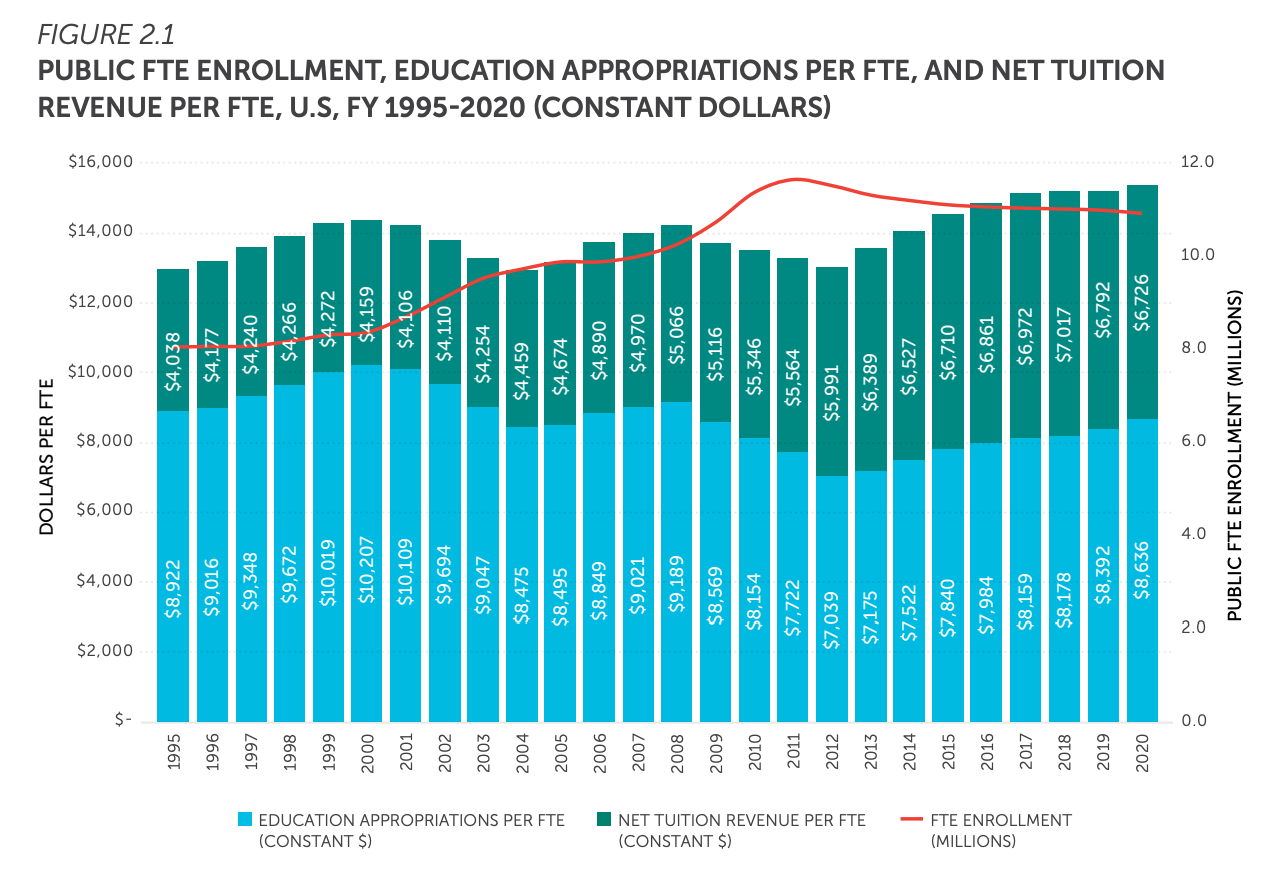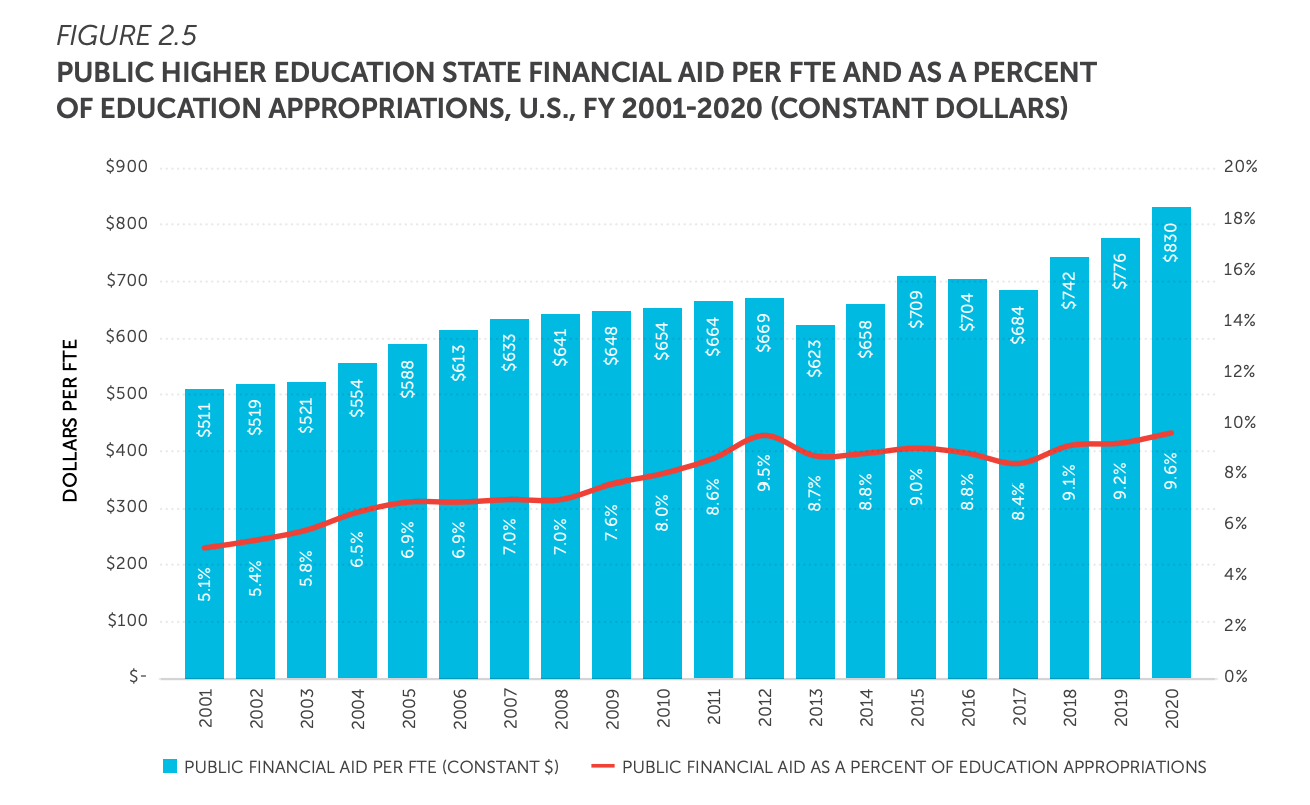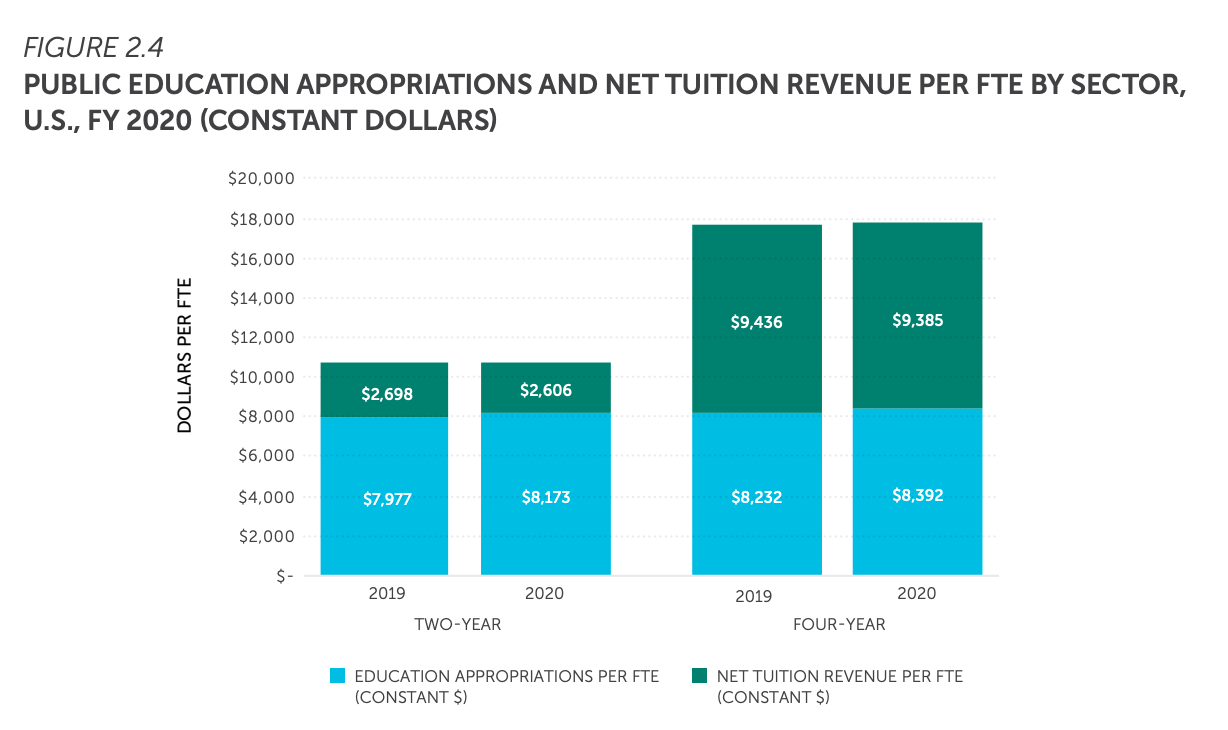You have /5 articles left.
Sign up for a free account or log in.

William_Potter/iStock/Getty Images
State and local education appropriations per full-time student increased for the eighth consecutive year in the 2020 fiscal year, rising by nearly 3 percent, according to the State Higher Education Executive Officers Association's latest State Higher Education Finance report.
Higher education appropriations per full-time-equivalent student increased by 2.9 percent after adjusting for inflation, to an average of $8,636 in the 2020 fiscal year, which began July 1, 2019, and ended June 30, 2020. Combined, state and local support totaled $108 billion. That figure includes $428 million in federal stimulus funding, which helped offset midyear spending cuts implemented by some states in response to the pandemic.
Since the COVID-19 pandemic first strained state budgets last spring, experts have warned that public higher education could experience devastating cuts in future years. Federal assistance helped ease some of those concerns, said Brian Prescott, vice president at the National Center for Higher Education Management Systems, a nonprofit group focused on higher education strategy for institutions and states.
Despite years of increases, state and local funding for public higher education has not fully recovered from cuts made during the 2008 recession, the SHEEO report said. As a result, public higher education entered the pandemic-related recession with historically low state funding levels.
“I definitely don’t want to de-emphasize the fact that we had an increase this year. I think that's great,” said Sophia Laderman, a senior policy analyst at SHEEO and lead author of the report. “Although we did have an increase this year, it just wasn’t quite enough to make up for all of the cuts in the last two recessions.”
 Enrollment trends this academic year have bucked trends observed in past recessions. State and local funding could follow suit, according to Laderman. That said, if the next few years do mirror past recessions, states are likely to cut higher education funding further.
Enrollment trends this academic year have bucked trends observed in past recessions. State and local funding could follow suit, according to Laderman. That said, if the next few years do mirror past recessions, states are likely to cut higher education funding further.
“This recession is very different because it was caused by the pandemic, and I think there’s the potential for states to bounce back and for higher education to bounce back faster,” Laderman said. “Past trends are also not always a great predictor of what’s happening currently. We’ve certainly seen that past trends in enrollment did not hold this recession, for example.”
State and local appropriations varied quite a bit from state to state in fiscal year 2020. Vermont allocated the smallest amount per full-time student -- $3,387. Wyoming led the country in per-student funding, appropriating $21,802 per full-time student, according to the report.
The annual State Higher Education Finance report examines state and local funding for public higher education institutions. The data include national trends in state and local spending, as well as state-by-state analyses. Most of the dollar figures in the report are adjusted for inflation unless otherwise noted.
State taxes and nontax appropriations -- a category that includes state lotteries, tobacco settlements and casinos and other gaming sources -- accounted for 89 percent of state and local higher education funding in fiscal year 2020. A handful of southern states -- Florida, Georgia, Kentucky and South Carolina -- relied on nontax support for at least a fifth of higher education funding. Another 24 states and Washington, D.C., did not have any nontax support for higher education.
Local tax appropriations made up about 11 percent of state and local higher education funding, the report stated.
Most state and local support for higher education -- 78 percent -- paid for general operations at public colleges and universities, the report said. Another 10 percent was used for research, agricultural extension programs and medical schools. About 8.4 percent was earmarked for student financial aid at public institutions, and less than 3 percent of state and local funding went to private institutions.
 While overall education appropriations fell during the 2001 and 2008 recessions, state funding for financial aid has increased steadily for two decades. State public financial aid per full-time student jumped 7 percent during fiscal year 2020 to an all-time high of $830. Funding for financial aid makes up 9.6 percent of total state and local higher education appropriations, the largest share in 20 years, the report said.
While overall education appropriations fell during the 2001 and 2008 recessions, state funding for financial aid has increased steadily for two decades. State public financial aid per full-time student jumped 7 percent during fiscal year 2020 to an all-time high of $830. Funding for financial aid makes up 9.6 percent of total state and local higher education appropriations, the largest share in 20 years, the report said.
Greater state investment in financial aid helps students, but not institutions, Laderman said. As states pour more money into financial aid programs, less is allocated for general operations at colleges and universities. Meanwhile, institutional aid increased year over year, indicating that public institutions did not reduce the amount of financial aid they were doling out when state aid increased, Laderman said.
On average, public colleges and universities received $6,726 in net tuition revenue from in-state and out-of-state students in fiscal 2020, which reflects a decline of 1 percent year over year. Most of this decline was concentrated at two-year institutions. Net tuition revenue per student at two-year institutions declined by 3.5 percent to $2,606. At four-year institutions, net tuition revenue per student slipped by 0.5 percent to $9,385.
This decline bucks a trend. Since 2001, net tuition revenue per full-time-equivalent student has increased by 61.7 percent.
The unusual decline highlights the financial strain on public institutions, Prescott said.
“The shape that the state budgets are going to be in as we move forward is even better than we thought they might be, but still I think that there might be some fragility there,” Prescott said. “The thing that really strikes me is the net tuition revenue shortfalls that are being experienced across the nation as a whole.”
The SHEEO report broke down state and local support by sector for the first time this year. During fiscal year 2020, education appropriations increased by 2.3 percent at two-year institutions and by 4 percent at four-year institutions in unadjusted dollars, according to the report.
 Over all, four-year institutions receive much more support from states than two-year institutions, the report showed.
Over all, four-year institutions receive much more support from states than two-year institutions, the report showed.
“They receive more in state operating appropriations that go right to the institution, they receive more in financial aid for their students and they receive these research and medical dollars as well,” Laderman said.
The unequal support has consequences for student outcomes.
“We know that state funding and total revenue impact graduation rates,” Laderman said. “Why are we giving more public support to students who seem to need it the least?”
States to Watch
The report’s top-line figures paint a broad picture of state and local support for higher education across the country, but stories vary quite a bit state by state.
Laderman said that Arizona, Oklahoma and Louisiana are important states to watch. All three states have decreased funding to public higher education by about 40 percent since 2008. Arizona saw a 42.7 percent decline, Oklahoma weathered a 38.6 percent decline and Louisiana has decreased higher education appropriations by 37.3 percent, the report shows.
“They’ve seen really no recovery since the last recession,” Laderman said. Meanwhile, education appropriations in 18 states have recovered to at least 2008 levels.
Since 2010, net tuition revenue per student increased by 44.2 percent in Arizona, 78.4 percent in Oklahoma and 64.5 percent in Louisiana.
California is a success story for two-year institutions, Laderman said. Net tuition as a percent of total education revenue at two-year colleges in the state is less than 3 percent, which is far lower than the national average of 24.2 percent.
“Unlike basically every other state, in fact, the California Community Colleges are still truly publicly funded,” Laderman said. “Most of that is due to really generous financial aid.”
Vermont and New Hampshire are also important states to keep an eye on, Prescott said. Both are small states without major cities and are facing significant demographic shifts.
“It’s even worse if you're a state like Vermont or New Hampshire that relies so heavily on net tuition revenue to drive institutional budgets,” Prescott said. “And at the same time, you are at the beginning stages of a long-term decline in the number of students that you think you’re going to be able to enroll.”




